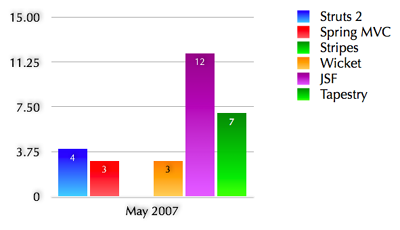Java Web Framework Tools: How many are there?
How many tools are there for the various open source web frameworks in Java? Here's my count:

So where did I get these numbers?
Struts 2's number (4) is based on tmjee's comment on a recent post. Spring MVC consists of Spring IDE, Gaijun Studio and IDEA (which supports Spring XML code-completion). There's no Stripes tools that I know of. JSF's number (12) is from research I did in October 2005 (if you have a definitive list, let me know). Tapestry has Spindle (which only supports 3.0) and 4.0 has an IDEA Plugin. Wicket has NetBeans support (which also exists for JSF (+Facelets), Tapestry and WebWork).
Please let me know if you have any corrections to these numbers. You can also download my presentation if you'd like to refute anything before tomorrow morning. It's noon in Amsterdam right now, so you have 18 hours or so.
Update: I've updated the graphs based on comments. Thanks for your input!


Posted by Gwyn Evans on May 03, 2007 at 10:46 AM MDT #
Posted by Phil on May 03, 2007 at 11:00 AM MDT #
Posted by Rob Breidecker on May 03, 2007 at 01:27 PM MDT #
Posted by Jesse Kuhnert on May 03, 2007 at 01:40 PM MDT #
Please do a find-and-replace s/Webwork/Struts 2/g . The presentation is too inconsistent and would be confusing for those who are don't already know that webwork is the predecessor to struts2.
Otherwise, a great presentation. It is a great service to the java web-development community.
Posted by Keith Weinberg on May 03, 2007 at 01:48 PM MDT #
Posted by Manny on May 03, 2007 at 01:51 PM MDT #
This is an interesting post, but in my opinion *very* skewed. Wicket is a web framework that is "Just Java", so it doesn't need any special tools or IDE plugins. Wicket has a very active community contributing "libraries and components" instead of building development tools.
JSF is a perfect example. Why are there so many JSF tools available? Because it's impossible to develop productively with "standard" JSF.
Just my 2 cents. Looking at this graph makes it *appear* that JSF is the bomb, when in fact it just has a number of required tools to even make it usable.
Posted by Ryan Sonnek on May 03, 2007 at 02:10 PM MDT #
Posted by Demian Neidetcher on May 03, 2007 at 02:41 PM MDT #
Posted by Anthony on May 03, 2007 at 04:29 PM MDT #
Posted by Scott Swank on May 03, 2007 at 05:56 PM MDT #
Posted by Scott Swank on May 03, 2007 at 05:58 PM MDT #
Posted by James Brundege on May 03, 2007 at 08:12 PM MDT #
The last part is pretty awesome actually. You can develop any page, panel or whatever, including the markup, javascript, css files and e.g. images it needs, jar it and if it is in your class path, you can use it *without a single line of configuration or build magic*.
Posted by Eelco Hillenius on May 04, 2007 at 12:20 AM MDT #
Posted by Eelco Hillenius on May 04, 2007 at 12:33 AM MDT #
Posted by Eelco Hillenius on May 04, 2007 at 12:39 AM MDT #
Posted by Eelco Hillenius on May 04, 2007 at 12:44 AM MDT #
Posted by Ignacio Coloma on May 04, 2007 at 08:11 AM MDT #
Posted by Alessandro Gasparini on May 04, 2007 at 10:03 AM MDT #
Not to sound like an activist for JBoss, but JSF is more or less worthless without Seam. However, with Seam in the picture, JSF has a fair shot at being the best framework choice in the market. It's a shame that JSF has to be considered by itself, since those days are all but gone. Eventually the underlying issues with the life cycle will get resolved as JSF 2 and WebBeans converge, but until then, Seam does a tremendous job of hiding the issue. I would also add that Ajax4jsf is pretty much a part of JSF now. You really wouldn't want to use JSF without it.
Web frameworks will always be a personal choice just like a person's favorite flavor of ice cream. I happen to see a strong future for Seam. JSF alone is like sugar and milk...the fundamental ingredients of ice cream, but not yet a full product.
Posted by Dan Allen on May 06, 2007 at 08:51 PM MDT #